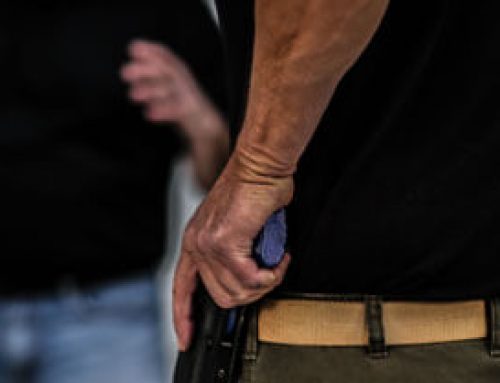A necessary skill to have on board should you find yourself in an exigent situation, is the ability to make sound tactical decisions and in a timely manner. In other words – use better judgement.
Needing to make an urgent decision introduces additional and contributing factors. Although interrelated these are best addressed individually: your decision is not an easy one, it must be made in a timely manner, and the level of importance is commensurate with the price for failure.
Rock and a Hard Place
If your decision was an easy one such as choosing your favorite ice cream flavor, then it’s not a difficult choice because the outcome is without significant consequence. Easy decisions are not such a pressing issue. However, the higher the resulting stakes, the greater the pressure increase to make the most appropriate choice.
Case in point. You find yourself at a shopping mall about an arms-length reach from an exterior steel door located in the middle of a solid brick exterior wall. You are with your family when you observe an active shooter about twenty yards away who is popping rounds into the ceiling and swinging his gun around covering nearby panicked shoppers with his muzzle. You observe him spot your yourself and your family. Whether you’re a trained shooter or off-duty officer and have the skill to stop the threat with your concealed carry pistol, your two immediate choices might be to rapidly exit the building with your family or slug it out with the active killer. As a civilian you are under no obligation. As a law enforcement officer (LEO) you are sworn to uphold the law.
Both options are viable, yet you know that you must make a sound tactical decision. What makes it difficult is that as either a civilian or LEO you are caught between the Scylla and Charybdis and must make an optimal decision for all involved.
When you minimize risk, you maximize safety. Your best bet is to weigh your options toward the result of lower risk. If you simply stand there and do nothing, then you run the risk of yourself and those nearest you incurring severe bodily harm or possibly death. If you decide to engage the threat with your handgun, then although you may be able to stop the threat because of your training, part of this option includes you and those nearest you being exposed to greater risk.
You could change your immediate position and move to a piece of good cover but then you’ve not readily gained any tactical advantage and must reassess the entire situation again from the beginning with the clock ticking.
Your next most effective option might be to remove your family entirely from harms’ way with the least amount of risk. Opening the readily accessible exterior steel door, ushering them through and securing that door behind you, lowers their risk potential, affords you more options and provides you better threat control.
Timely
Another contributing factor to the degree of difficulty when pressed with a difficult decision, is a time requirement which much be part and parcel of your deliberation process.
In the time flow of any continuous series of cascading undesired events from inception, you will find yourself taking either proactive measures, active measures or reactive measures. Failing to see it, hear it, smell it coming means that you are forced to respond to a clear and present danger with reactive measures which translates to having the least amount of time and the least number of options.
In assessing your situation another consideration in taking reactive measure is “If I take this course of action, then it’s going to cost me ‘x’ amount of time. However, if I move in that direction and take that course of action, then it’s going to cost me less time.”
Your mind must additionally process new and relevant information to make an accurate decision. Processing good information and in a timely manner equates to better judgement. However, you can’t spend all day. It takes anywhere from a tenth to a quarter of second to process a single thought. Burning too much time on the deliberation process attenuates your action-reaction timetable introducing additional pressure.
Does a half-second matter in a two-way gunfight? In reactive response to an active threat, you are behind the action-reaction power curve and time is of the essence.
Cost Effective
In mitigating any violent physical threat, the price tag for failure can be excessive. The higher the price tag the higher the priority and with time not on your side, better judgement is a matter of weighing out the pros and cons, with alacrity, to include the cost of each choice.
What level of injury might be incurred because of this decision? Is this a justifiable use of force? What are the legal ramifications? Will my actions be the cause of any collateral damage? Is it best to devise a shooting or non-shooting solution to solve the tactical problem?
Observe and address each contributing factor. Good information helps you make good decisions. Accurately assess relevant incoming information. You cannot tarry as time is never on your side when applying reactive measures.
In any dynamic combative environment, there is no free lunch. No choice is without consequence. In making sound, timely and ‘cost-effective’ decisions, better judgement places you ahead of the action-reaction power curve when the stakes are raised.






